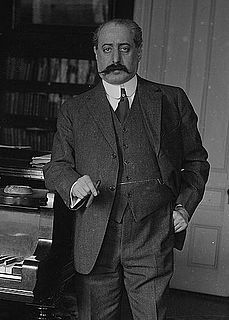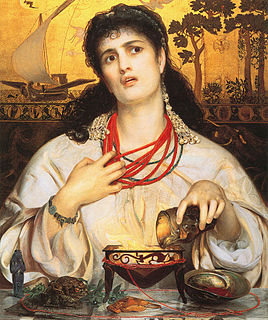Related Research Articles

Aaron Copland was an American composer, composition teacher, writer, and later a conductor of his own and other American music. Copland was referred to by his peers and critics as "the Dean of American Composers". The open, slowly changing harmonies in much of his music are typical of what many people consider to be the sound of American music, evoking the vast American landscape and pioneer spirit. He is best known for the works he wrote in the 1930s and 1940s in a deliberately accessible style often referred to as "populist" and which the composer labeled his "vernacular" style. Works in this vein include the ballets Appalachian Spring, Billy the Kid and Rodeo, his Fanfare for the Common Man and Third Symphony. In addition to his ballets and orchestral works, he produced music in many other genres, including chamber music, vocal works, opera and film scores.

Rubin Goldmark was an American composer, pianist, and educator. Although in his time he was an often-performed American nationalist composer, his works are seldom played now. Today he is best known as the teacher of other important composers, including Aaron Copland and George Gershwin.

The Firebird is a ballet and orchestral concert work by the Russian composer Igor Stravinsky. It was written for the 1910 Paris season of Sergei Diaghilev's Ballets Russes company; the original choreography was by Michel Fokine, who collaborated with Alexandre Benois on a scenario based on the Russian fairy tales of the Firebird and the blessing and curse it possesses for its owner. It was first performed at the Opéra de Paris on 25 June 1910 and was an immediate success, catapulting Stravinsky to international fame. Although designed as a work for the stage, with specific passages accompanying characters and action, the music achieved equal if not greater recognition as a concert piece.
Appalachian Spring is a musical composition by Aaron Copland that was premiered in 1944 and has achieved widespread and enduring popularity as an orchestral suite. The music, scored for a thirteen-member chamber orchestra, was created upon commission of the choreographer and dancer Martha Graham with funds from the Coolidge Foundation. It was premiered on Monday, October 30, 1944, at the Library of Congress in Washington D.C., with Martha Graham dancing the lead role. The set was designed by the American sculptor Isamu Noguchi. Copland was awarded the 1945 Pulitzer Prize for Music for his achievement.

Connotations is a classical music composition for symphony orchestra written by American composer Aaron Copland. Commissioned by Leonard Bernstein in 1962 to commemorate the opening of Philharmonic Hall in New York City, United States, this piece marks a departure from Copland's populist period, which began with El Salón México in 1936 and includes the works he is most famous for such as Appalachian Spring, Lincoln Portrait and Rodeo. It represents a return to a more dissonant style of composition in which Copland wrote from the end of his studies with French pedagogue Nadia Boulanger and return from Europe in 1924 until the Great Depression. It was also Copland's first dodecaphonic work for orchestra, a style he had disparaged until he heard the music of French composer Pierre Boulez and adapted the method for himself in his Piano Quartet of 1950. While the composer had produced other orchestral works contemporary to Connotations, it was his first purely symphonic work since his Third Symphony, written in 1947.
The Tender Land is an opera with music by Aaron Copland and libretto by Horace Everett, a pseudonym for Erik Johns.
Aaron Copland's Clarinet Concerto was written between 1947 and 1949, although a first version was available in 1948. The concerto was later choreographed by Jerome Robbins for the ballet Pied Piper (1951).
The Piano Variations of American composer Aaron Copland were written for piano solo from January to October 1930. They were dedicated to American writer and literary critic Gerald Sykes, and were originally published in 1932 by Cos Cob Press, which merged with Arrow Music Press in 1938 and was taken over by Boosey & Hawkes in 1956. The approximate performance time is 11 minutes.
Moves is a ballet choreographed by Jerome Robbins. The ballet was made for Robbins's troupe Ballet: USA's 1959 tour, with Aaron Copland brought in to write the music. However, he struggled with the score, and Robbins ultimately decided to have the ballet performed in silence instead. The ballet premiered at the Festival of Two Worlds held in Spoleto, Italy, on July 3, 1959. It has since been revived by other dance companies, including the New York City Ballet. Copland's score was later published as Dance Panels.
In the Night is a ballet choreographed by Jerome Robbins to four nocturnes by Frédéric Chopin. It premiered on January 29, 1970 at the New York State Theater, performed by the New York City Ballet.
The Goldberg Variations is a ballet choreographed by Jerome Robbins to Bach's Goldberg Variations. A plotless ballet, it starts with two performers dancing to the Theme, followed by the variations divided into two parts, with variations repeated as Bach had intended in the score. Robbins made the ballet for the New York City Ballet, and premiered on May 27, 1971, at the New York State Theater.

Dances at a Gathering is a ballet choreographed by Jerome Robbins to music by Frédéric Chopin, with costumes designed by Joe Eula. The ballet premiered on May 22, 1969, at the New York State Theater, performed by the New York City Ballet.
Other Dances is a ballet choreographed by Jerome Robbins to music by Frédéric Chopin. It was created on Natalia Makarova and Mikhail Baryshnikov, and premiered on May 9, 1976, at a gala benefitting the New York Public Library for the Performing Arts, held at Metropolitan Opera House. It was originally made as a pièce d'occasion, but after receiving critical acclaim, it was soon added to American Ballet Theatre and New York City Ballet's repertories.
Fanfare is a one-act ballet choreographed by Jerome Robbins to Benjamin Britten's The Young Person's Guide to the Orchestra, in celebration of the Coronation of Queen Elizabeth II. The ballet premiered on June 2, 1953, the night of the coronation, at the City Center of Music and Drama, danced by the New York City Ballet.
Harold Shapero completed the Symphony for Classical Orchestra in B-flat major on March 10, 1947, in Newton Centre, Massachusetts. It is written for an orchestra consisting of piccolo, 2 flutes, 2 oboes, 2 clarinets in B-flat, 2 bassoons, contrabassoon, 2 horns in F, 2 trumpets in C, 2 tenor trombones and one bass, timpani and strings. Although labelled "Classical," many of the work's features point to Beethoven rather than Haydn or Mozart, such as "the way in which Shapero paces himself, alternating long passages in the tonic and the dominant, with fast, dramatic modulations often reserved for transitions and developments." Nicolas Slonimsky remarked on how the piece is "premeditatedly cast in the proclamatory key of B-flat major, the natural tonality of the bugle, and ending in a display of tonic major triads." But there are modern features as well, with "the work's orchestration, in general, ... distinctively bright and brassy, and undoubtedly derived a fair amount from Piston and Copland, as well as from the composer's experience as a dance band arranger."
Rodeo is a ballet composed by Aaron Copland and choreographed by Agnes de Mille, which premiered in 1942. Subtitled "The Courting at Burnt Ranch", the ballet consists of five sections: "Buckaroo Holiday", "Corral Nocturne", "Ranch House Party", "Saturday Night Waltz", and "Hoe-Down". The symphonic version omits "Ranch House Party", leaving the other sections relatively intact.
Aaron Copland wrote the Symphony for Organ and Orchestra in 1924. It represents a major work in the composer's oeuvre, as it was his first fully realized orchestral work, his first work for organ, and the first piece whose orchestration he heard. It was premiered on January 11, 1925, in New York. In 1928, Copland re-orchestrated the work without organ as his Symphony No. 1, rewriting the organ part in the brass and adding saxophone.

La hija de Cólquide is a ballet score composed by Carlos Chávez in 1943–44 on commission from the Elizabeth Sprague Coolidge Foundation for Martha Graham. The title refers to the mythological character Medea, daughter of King Aeëtes of Colchis, in the story of Jason and the Golden Fleece. The ballet spawned several subsidiary works in Chávez's catalog including his Third String Quartet. When Graham eventually choreographed it, she wrote a new scenario and gave it the title Dark Meadow.

Danzón cubano is a composition for two pianos by American composer Aaron Copland. The piece, written in 1942, was inspired by the Cuban genre of the same name. It was first arranged for orchestra in 1946.
The Short Symphony, or Symphony No. 2, is a symphony written by the American composer Aaron Copland from 1931 to 1933. The name derives from the symphony's short length of only 15 minutes. The work is dedicated to Copland's friend, the Mexican composer and conductor Carlos Chávez. The symphony's first movement is in sonata-allegro form, and its slow second movement follows an adapted ternary form. The third movement resembles the sonata-allegro but has indications of cyclic form. The composition contains complex rhythms and polyharmonies, and it incorporates the composer's emerging interest in serialism as well as influences from Mexican music and German cinema. The symphony includes scoring for a heckelphone and a piano while omitting trombones and a percussion section. Copland later arranged the symphony as a sextet.
References
- Butterworth, Neil (1986). The Music of Aaron Copland. New York: Universe Books. ISBN 0-87663-495-1.
- Copland, Aaron; Perlis, Vivian (1989). Copland Since 1943. New York: St. Martin's Press. ISBN 0-312-03313-3.
- Jowitt, Deborah (2004). Jerome Robbins: His Life, His Theater, His Dance. New York: Simon & Schuster. ISBN 0-684-86985-3.
- Pollack, Howard (1999). Aaron Copland: The Life and Work of an Uncommon Man. New York: Henry Holt and Company. ISBN 9780805049091.
- Slonimsky, Nicolas (1994). Music Since 1900: Fifth Edition. New York: Schirmer Books. ISBN 0-02-872418-6.